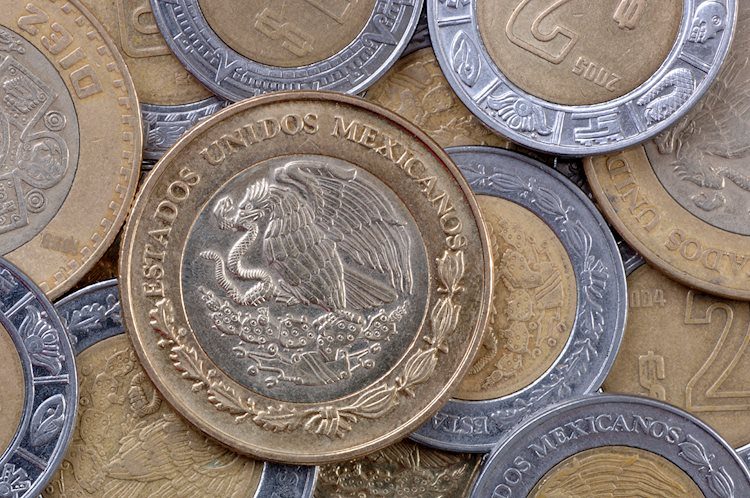- Mexican Peso declines for fourth day as USD/MXN recovers from daily low of 19.29.
- Mexico’s Economic Activity expanded in July, but Retail Sales contracted for the third consecutive month, fueling Peso weakness.
- Citibanamex survey shows most economists expect Banxico to cut rates by 25 bps on Thursday, with some forecasting a 50-bps cut.
The Mexican Peso extended its losses for the fourth straight day against the Greenback, erasing earlier gains as traders digested mixed economic data from Mexico, while S&P Global revealed that business activity in the US remains solid but ticked lower. The USD/MXN trades at 19.45, bouncing off a daily low of 19.29, gaining 0.21%.
Mexico’s Instituto Nacional de Estadística Geografía e Informatica (INEGI) revealed that Economic Activity expanded in July, while Retail Sales contracted for the third straight month, yet improved compared to June’s reading.
Mexico’s economic docket will reveal September’s mid-month inflation figures on Tuesday, ahead of the Bank of Mexico (Banxico) monetary policy decision on Thursday. Citibanamex Expectations Survey showed that 28 of 36 economists await a 25-basis-point (bps) rate cut by the Mexican central bank. It’s worth noting that six of them forecast a 50 bps cut, and two others project the next cut until November 2024.
Across the border, US Flash PMIs were mixed, with manufacturing activity contracting deeper while services continued to underpin the economy. The Atlanta Fed GDP Now model estimates the US economy will grow 2.9% in the third quarter and will be updated on Friday following data releases.
Recently, the USD/MXN extended its losses after Fed speakers acknowledged that the risks of the labor market weakening had increased. However, they pushed back against lowering interest rates at a 50 bps pace, keeping their options open for the upcoming meetings.
Daily digest market movers: Mexican Peso retreats as Fed officials push back against aggressive easing cycle
- Mexico’s Economic Activity in July expanded by 0.6% MoM, up from 0% in June. In the 12 months to July, ur grew 3.8%, crushing expectations of 1.8% and June’s -0.6% contraction.
- Retail Sales improved from -0.5% to 0.7% MoMy. They shrank -0.6% YoY, more than estimates of -0.5% but improved from -3.1%.
- Banxico is expected to lower borrowing costs by 175 bps, according to the swaps markets.
- US S&P Global Manufacturing PMI in September deteriorated further from 47.9 in August to 47.0, below forecasts of 48.5. Nevertheless, the Services PMI expanded by 55.4, above estimates of 55.3 but beneath the previous month’s 55.7, hinting that the US economy is decelerating.
- Regional Fed presidents crossed the newswires. Minneapolis’ Neel Kashkari said the Fed remains data-dependent, that cutting 50 bps was “the right decision,” and projected the fed funds rate to end at 4.4% in 2024.
- Atlanta Fed’s Raphael Bostic commented that a half-point cut “does not lock in a cadence for future rate cuts,” while adding that risks to the labor market had increased.
- Chicago Fed’s Austan Goolsbee said many more rate cuts are needed next year.
USD/MXN technical analysis: Mexican Peso drops after weak US PMI data
The USD/MXN is upwardly biased. It recovered slightly during the North American session and is set to extend its gains once the psychological 19.50 figure is surpassed. Momentum as measured by the Relative Strength Index (RSI) favors buyers, after crossing above its neutral line, opening the door for further gains.
The USD/MXN’s next resistance will be 19.50, followed by the August 6 high at 19.61. Once cleared, the 20.00 will follow, followed by the year-to-date (YTD) peak at 20.22. Conversely, if USD/MXN extends its losses below the September 23 low of 19.29, it will expose the confluence of the 50-day Simple Moving Average (SMA) and the September 18 low near 19.08 to 19.06.
Banxico FAQs
The Bank of Mexico, also known as Banxico, is the country’s central bank. Its mission is to preserve the value of Mexico’s currency, the Mexican Peso (MXN), and to set the monetary policy. To this end, its main objective is to maintain low and stable inflation within target levels – at or close to its target of 3%, the midpoint in a tolerance band of between 2% and 4%.
The main tool of the Banxico to guide monetary policy is by setting interest rates. When inflation is above target, the bank will attempt to tame it by raising rates, making it more expensive for households and businesses to borrow money and thus cooling the economy. Higher interest rates are generally positive for the Mexican Peso (MXN) as they lead to higher yields, making the country a more attractive place for investors. On the contrary, lower interest rates tend to weaken MXN. The rate differential with the USD, or how the Banxico is expected to set interest rates compared with the US Federal Reserve (Fed), is a key factor.
Banxico meets eight times a year, and its monetary policy is greatly influenced by decisions of the US Federal Reserve (Fed). Therefore, the central bank’s decision-making committee usually gathers a week after the Fed. In doing so, Banxico reacts and sometimes anticipates monetary policy measures set by the Federal Reserve. For example, after the Covid-19 pandemic, before the Fed raised rates, Banxico did it first in an attempt to diminish the chances of a substantial depreciation of the Mexican Peso (MXN) and to prevent capital outflows that could destabilize the country.
Read the full article here

